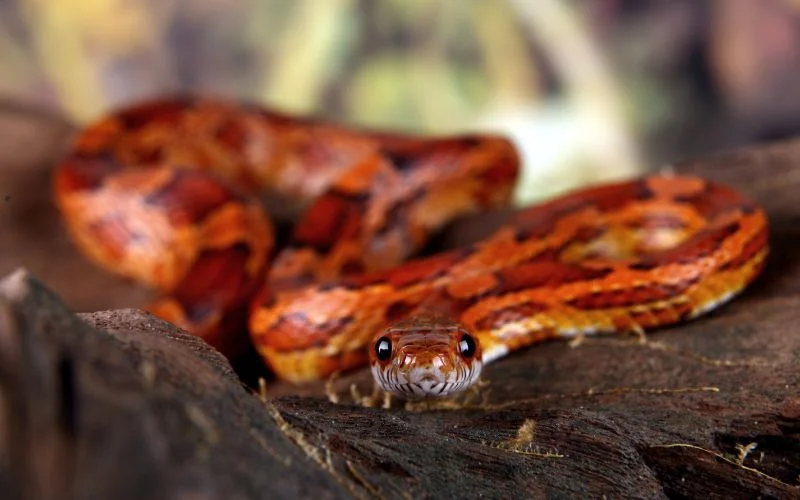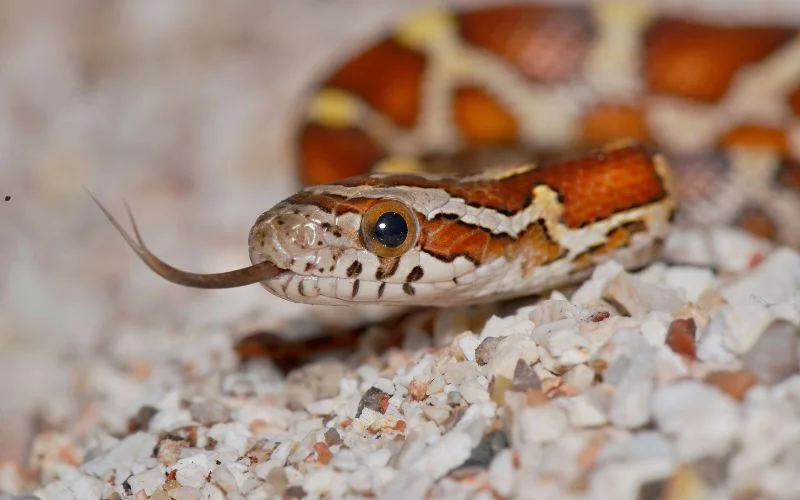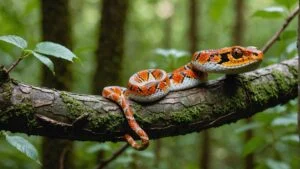When considering the size of a corn snake, you’ll find that adults typically range from 3 to 5 feet in length, with some reaching up to 6 feet under ideal conditions. Females often grow larger than males due to their need to produce eggs. From hatchlings starting at about 10-12 inches to juveniles reaching 2-3 feet in their first year, growth can vary based on genetics, diet, and environment. But what exactly influences these variations, and how can you guarantee your corn snake reaches its full potential? Let’s explore the key factors that play a role.
Key Takeaways
- Adult corn snakes typically reach lengths of 3 to 5 feet.
- Female corn snakes are generally larger than males.
- Hatchlings measure about 10-12 inches long.
- By one year, juveniles can be 2 to 3 feet long.
- Adults usually reach 4 to 6 feet by 2-3 years of age.
Average Adult Size


Adult corn snakes typically reach lengths of 3 to 5 feet on average. If you’re thinking about getting one as a pet, it’s important to understand their size. Many people make size comparisons between corn snakes and other common snakes like ball pythons. While corn snakes are generally slimmer and more manageable, they can still surprise you with their length.
There are common myths floating around about corn snakes that can be misleading. One myth is that corn snakes can grow indefinitely if given enough food and space. Unlike some reptiles, corn snakes have a genetic limit to their growth, typically capping at around 5 feet.
Another myth you might hear is that they’re either too small to be impressive or too large to handle easily. The reality is that their moderate size makes them ideal pets for both beginners and experienced snake owners.
Understanding the average size of adult corn snakes helps you better prepare for their care. You’ll need an appropriately sized enclosure and enough space to handle them comfortably.
Growth Stages
Corn snakes undergo several distinct growth stages, from hatchlings to fully grown adults. Right from the start, you’ll notice how rapidly they change. In the hatchling phase, corn snakes are tiny, measuring about 10-12 inches long. They grow quickly in their first year, and this period marks an important part of their juvenile development. You’ll see them shed their skin frequently, a sign they’re growing.
As juveniles, corn snakes continue to lengthen and gain weight. By the time they reach one year old, they can be anywhere from 2 to 3 feet long. During this phase, their feeding frequency and diet significantly affect their growth rates. It’s crucial to keep a close eye on their health and ensure they have the right environment to thrive.
Finally, their growth rate decreases as they progress from juveniles to adults. By 2-3 years, corn snakes typically reach their full adult size, ranging from 4 to 6 feet. Their shedding becomes less frequent at this stage, and their dietary needs shift to maintain their size.
| Growth Stage | Length | Key Characteristics |
|---|---|---|
| Hatchling | 10-12 inches | Rapid growth, frequent shedding |
| Juvenile | 2-3 feet | Continued growth, dietary needs |
| Adult | 4-6 feet | Slower growth, maintenance feeding |
Factors Affecting Growth
Understanding the factors that impact their growth will help you guarantee your corn snake reaches a healthy adult size. By managing these elements, you can create the best environment for your pet.
Here are three key factors to keep in mind:
- Temperature regulation: Corn snakes are ectothermic, meaning they rely on external heat sources to regulate their body temperature. Maintaining the right temperature gradient in their enclosure is vital. A basking spot around 85-90°F and a cooler area around 75°F will promote proper metabolism and growth.
- Genetic predisposition: Like any other living creature, genetics significantly determine how big your corn snake will get. Some corn snakes are naturally predisposed to grow larger or smaller based on their genetic makeup. Knowing your snake’s lineage can give you an idea of its potential adult size.
- Nutrition: A balanced diet is essential for healthy growth. Feeding your corn snake appropriately sized prey regularly will ensure it receives the nutrients it needs. Younger snakes typically eat more frequently than adults but always provide food items proportionate to the snake’s girth.
Gender Differences
Male and female corn snakes exhibit noticeable differences in size. This phenomenon, known as sexual dimorphism, plays a significant role in their growth and development.
Typically, female corn snakes tend to be larger than their male counterparts. You’ll often find that females can grow up to five feet long, whereas males usually max out around four feet.
One key reason behind this size difference is reproductive maturity. Female corn snakes need the extra body mass to support egg production and the energy demands of reproduction. When females reach reproductive maturity, usually around two to three years of age, their bodies are better suited to carry and lay eggs, thanks to their larger size.
On the other hand, males don’t require as much body mass since their primary role during reproduction is to locate and court females. Their smaller size aids in this process, allowing them to be more agile and efficient in searching for potential mates.
Geographic Variations


Geographic variations play a significant role in determining corn snakes’ size and growth patterns. Depending on where they live, corn snakes can exhibit different physical characteristics influenced by their environment. Regional adaptations guarantee these snakes thrive in various habitats, from the southeastern United States to northern Mexico.
Climate impact is a major factor. Corn snakes grow larger in warmer regions due to a longer active season, giving them more time to hunt and feed. Conversely, their growth may be stunted in cooler areas due to shorter active periods and limited food availability.
Here are three key points to take into account:
- Southeastern U.S.: Corn snakes here often grow larger, reaching up to 6 feet, thanks to the warm, humid climate that promotes year-round activity.
- Northern Regions: In cooler climates like those in the north of the U.S., corn snakes typically stay smaller, averaging around 3-4 feet due to shorter summers and longer hibernation periods.
- Arid Zones: In drier areas, corn snakes may adapt by conserving energy, which can also limit their size. They might only reach about 4-5 feet, adjusting to the scarcity of prey and water.
Understanding these geographic variations helps you appreciate the adaptability and resilience of corn snakes.
Diet and Nutrition
While geographic variations influence their size, a corn snake’s diet and nutrition are equally vital factors in their growth and overall health. You should provide a balanced diet of appropriately sized rodents like mice or rats to ensure your corn snake thrives.
The feeding frequency for young corn snakes is generally once every 5-7 days, while adult snakes can be fed every 7-10 days. The feeding schedule must be adjusted based on the snake’s age, size, and activity level. Overfeeding can lead to obesity, while underfeeding can stunt growth and weaken the immune system. Always monitor your snake’s body condition and adjust accordingly.
Dietary supplements aren’t typically necessary for corn snakes if they consume whole prey, as they already contain the essential nutrients they need. However, if your snake’s diet lacks variety, consult a reptile vet for advice on appropriate supplements.
Proper Housing
Providing a properly sized and secure enclosure is vital to guaranteeing your corn snake thrives. A tank measuring at least 20 gallons is suitable for a juvenile, but adult corn snakes need a minimum of a 40-gallon tank. Ensure the tank dimensions allow for enough horizontal space, as these snakes like stretching out and exploring.
Choosing the right substrate is important for your snake’s comfort and health. Please refrain from using cedar or pine, as they can be toxic. Instead, consider these substrate options:
- Aspen Shavings are a popular choice due to their absorbency and ability to allow your snake to burrow.
- Cypress Mulch: Retains humidity well, which can be beneficial in drier climates.
- Reptile Carpet: Easy to clean and reusable, making it a low-maintenance option.
Additionally, ensure the enclosure has a secure lid to prevent escape attempts. Include hiding spots, climbing branches, and a water bowl large enough for soaking.
It is also important to keep the temperature gradient within the tank, with a warm side around 85°F and a cool side around 75°F. This setup will create a comfortable and stimulating environment for your corn snake.
Health and Wellness
Ensuring your corn snake’s health and wellness involves regular monitoring and proper care practices. First, maintaining good hygiene practices is essential. Clean the enclosure regularly by removing waste and uneaten food. This prevents bacterial buildup and keeps your snake’s environment safe. Also, fresh water should be provided daily to avoid dehydration and contamination.
Stress management is another key factor. Corn snakes can become stressed from abrupt changes in their environment or handling. Create a stable habitat with hiding spots and consistent temperature to minimize stress. Handle your snake gently and avoid sudden movements.
It is vital to feed your corn snake appropriately. Offer prey items the right size—typically no larger than the snake’s widest part. Overfeeding or underfeeding can lead to health complications. Monitor their eating habits and adjust as necessary.
Regular health checks are important. Look for signs of lethargy, abnormal shedding, or respiratory issues. If you notice any concerning symptoms, consult a reptile veterinarian.
Here’s a quick reference table for corn snake wellness:
| Aspect | Best Practices |
|---|---|
| Hygiene Practices | Regular cleaning and fresh water daily |
| Stress Management | Stable habitat, gentle handling |
| Feeding | Appropriately sized prey, regularity |
| Health Monitoring | Watch for illness signs, vet checkups |
Conclusion
To sum up, understanding how big corn snakes get helps you provide the best care for them. They can grow up to 6 feet, with females typically being larger.
Genetics, diet, and environment all influence corn snake growth. You can support your corn snake’s development and well-being by ensuring proper nutrition, housing, and health care.
So, keep these factors in mind for a happy, healthy snake!


